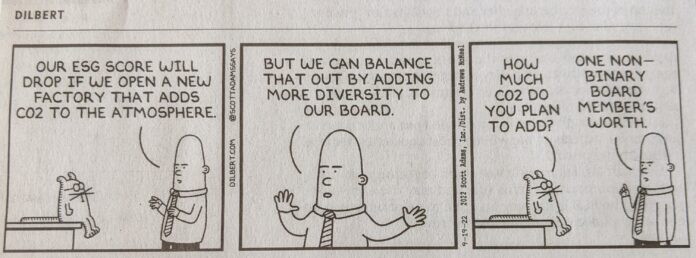In addressing sustainability and sustainable development goals (SDGs) businesses have embraced a new standard of measure that goes by the acronym ESG. The E stands for environment, the S for social, and the G for governance. Companies are being asked to quantify and measure their performance not just from bottom-line results or dividends distributed to shareholders, but by actions in support of these three pillars of sustainability. But ESG has no single standard bearer to data define it and as depicted in the Dilbert comic strip seen above, can become a sleight-of-hand trick.
Sleight-of-hand is bad enough but our world has been descending into a morass of counterfactual nonsense over the past few years. Remember Kellyanne Conway, a former counsellor to Donald Trump, who I believe was the first to utter the phrase “alternative facts” as she attempted to explain the crowd size claim of her President on that January day in 2017 when he was inaugurated. The President said these were the biggest crowds ever to witness an inauguration. He sent out his press secretary to reinforce this notion. But the photographs showed his claim was an outright lie.
Today, lies have become alternative facts and we are living with the consequences of a world losing its bearings. A good example comes from last weekend’s television interview by President Biden who stated that the COVID-19 pandemic was over. The World Health Organization (WHO) was quick to respond noting a very different reality based on facts. What did these show? September 19, 2022 infection rates globally were nearing 440,000 and daily deaths totalled 1,422.
So maybe Biden was only talking about COVID-19 in the U.S? But wait, U.S. numbers showed daily infection rate averages for the week of September 15th at more than 38,000 with 332 deaths. For those getting sick and dying from COVID-19, Biden’s claim is nonsense. Nonetheless, the President has the bully pulpit to preach his alternative facts. It’s no wonder, therefore, that many are skeptics about what is real and what is not, particularly when reliable data gets buried behind a non-factual narrative.
Nathan Greenfield, a journalist for University World News, recently wrote a piece asking the question – why so many mistrust science today. He referred to the Scopes Monkey Trial in the 1920s as an example of what was then a common public anti-science attitude about evolution. He then equated this with modern-day climate change denial spread by politicians, corporate shills, and fossil-fuel-bought scientists who spread their own versions of alternative facts.
When people in authority tell lies or misrepresent data, they undermine evidence backed by reliable data. They undermine science. They inhibit human progress.
Aviva Philipp-Muller, a professor at the Beedie School of Business, Simon Fraser University, recently published a paper in the Proceedings of the National Academy of Sciences of the United States of America (PNAS). In it, she and her coauthors state that scientists and other fact-bearers need to be better persuaders of truths and better explainers of how science works.
The COVID-19 pandemic provides us with a great illustration of how alternative facts fuelled by Presidents, and social media compete with science-based reality. It shows us that many people don’t understand the methodology of science and research.
When COVID-19 struck it was a bombshell. First, discovering its source was a challenge. Was it a Chinese wet market or concocted in a germ warfare laboratory?
A version of coronavirus scientists had seen earlier was called SARS. It spread from close contact, on contaminated surfaces, and from hand to hand. So we were told to wash our hands and wipe down surfaces to fight COVID-19. But further studies proved COVID-19 was an airborne virus that easily spread in indoor crowded settings.
Initial government responses across the planet included lockdowns, school cancellations, and work-from-home edicts. The airlines were the unknown conveyors of the disease to every part of the Global North and South. My wife and I were in Costa Rica as the pandemic marched across the planet. We were sitting poolside with neighbours talking about the poor people stuck on cruise ships where outbreaks had occurred unable to find a friendly port to disembark. Fear was overcoming public confidence in any science being reported in the press. Scientists like Dr. Anthony Fauci were vilified. So too the WHO.
Social media is roiled by conspiracy theories. The U.S. President early in the pandemic called COVID-19 the Chinese virus and told people at a press conference that shining light inside the body, or using bleach would kill it. From his bully pulpit, he pushed unproven drugs as cures.
Meanwhile, scientists and doctors recommended protocols such as mask-wearing, washing hands, and staying out of crowded indoor venues while they tested and developed breakthrough vaccines in record time. The vaccines alone should have restored our trust in science.
Who knew science needed to be marketed to the masses like a product? But apparently, that’s what the evidence shows. Resenting the messengers with their pedigrees has become the norm for a large percentage of the public today. Facts backed up by data no longer cut it. Scientists have to be selling. Scientists have to grab the bully pulpit, promote their work, speak in a language understood by the crowd, and win hearts and minds. Even then, the built-in resistance to both the message and the messenger will be a challenge.
I read research papers. An interesting phenomenon is starting to happen among those who write about their discoveries. Abstracts that summarize findings in some journals now come in two forms, one aimed at fellow academics and scientists to read, and a second written so that the public can understand. It sort of takes the fun out of what I do, which is to make scientific discovery palatable to readers who come to this blog site.
But let’s get back to ESG which has no scientific method behind it and, therefore, appears to be subjective and more a public relations effort by business and industry. Companies wave their ESG credentials at shareholders’ meetings and provide write-ups in annual reports. But ESG is far from scientific and another reason for the public to question the science of climate change since the E in ESG stands for the environment. And everyone knows that means climate change. ESG rating agencies have popped out of the woodwork. None appear to use the scientific method to come up with numbers. Some are using artificial intelligence (AI) which probably adds even more to public skepticism.
So how do we move away from the thinking that led to the Scopes Monkey Trial as a reflection of the rejection of science in the 1920s? Better yet how do we overcome those who own the bully pulpit and state alternative facts here in the 21st century?
Philipp-Muller believes resistance to facts will only come to an end through better science education. She comments, “If we can…ensure that people have good scientific reasoning skills so that when they’re presented with new scientific information, they are able to assess whether or not it’s valid, that will help ensure that they can get on board with accurate and valid scientific information and also learn what kind of evidence is shaky.” It’s a tall order to fill in a world increasingly distracted by alternative facts and noise coming at us from all directions.

















Well, because science is not about facts. It is a method. But scientific methods have been jettisoned for the sake of fame or money. And we should all be able to cite several examples of scientific fraud. We live in a time when science is run by corporations that pay studies for a specific result. Real science is hard to find and will likely have a hard time finding funding. Who wants to invest in something whose outcome is unpredictable?
The fact that certain science is suppressed, censored, and ridiculed does not inspire confidence either.
Scientists who claim to know the facts or declare that science is closed have not understood the scientific method at all.
Skepticism about “FACTS” is at the core of science.
https://viroliegy.com/